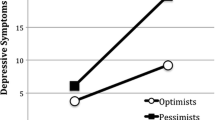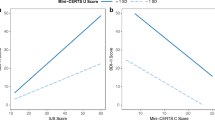Abstract
Anticipatory thoughts and feelings of defensively pessimistic and moderately depressed college students were compared in order to identify factors that distinguish effective strategies of negative thinking from those that may be maladaptive. Three components of anticipatory strategies — expectations, anxiety, and extent of preparation — were assessed at three times over the course of stressful social situations in the subjects' own lives. Defensive pessimists were similar to the moderately depressed subjects in that they reported negative expectations and high levels of anxiety before their events occurred. However, defensive pessimists (like optimists) did not share the depressed subjects' avoidant ways of coping. Although there were no apparent differences in the severity of the situations described by defensive pessimists and depressed subjects, only depressed subjects experienced residual anxiety and rumination after their events were over. Effective preparation before situations occur and nonavoidant ways of coping seem to distinguish the defensive pessimists' negative strategy from that of moderately depressed persons.
Similar content being viewed by others
References
Abramson, L. Y., Seligman, M. E. P., & Teasdale, J. D. (1978). Learned helplessness in humans: Critique and reformulation.Journal of Abnormal Psychology, 87 49–74.
Alloy, L. B., & Ahrens, A. H. (1987). Depression and pessimism for the future: Biased use of statistically relevant information in the predictions for self versus others.Journal of Personality and Social Psychology, 52 366–378.
Bandura, A. (1982). Self-efficacy mechanisms in human agency.American Psychologist, 37 122–147.
Baumgardner, A. H., & Brownlee, E. A. (1987). Strategic failure in social interaction: Evidence for expectatancy disconfirmation processes.Journal of Personality and Social Psychology, 52 525–535.
Beck, A. (1967).Depression: Clinical, experimental, and theoretical aspects. New York: Harper & Row.
Beck, A. (1976).Cognitive therapy and the emotional disorders. New York: International Universities Press.
Brown, J. D., & Siegel, J. M. (1988). Attributions for negative life events and depression: The role of perceived control.Journal of Personality and Social Psychology, 54 316–322.
Campbell, J. D., & Fairey, P. J. (1985). Effects of self-esteem, hypothetical explanations, and verbalization of expectancies on future performance.Journal of Personality and Social Psychology, 48 1097–1111.
Cantor, N., Norem, J. K., Niedenthal, P. M., Langston, C. A., & Brower, A. M. (1987). Life tasks, self-concept ideals, and cognitive strategies in a life transition.Journal of Personality and Social Psychology, 53 1178–1191.
Comstock, G. W., & Helsing, K. J. (1976). Symptoms of depression in two communities.Psychological Medicine, 6 551–563.
Dweck, C. S., & Gilliard, D. (1975). Expectancy statements as determinants of reactions to failure: Sex differences in persistence and expectancy change.Journal of Personality and Social Psychology, 32 1107–1110.
Feather, N. T. (1966). Effects of prior success and failure on expectations of success and subsequent performance.Journal of Personality and Social Psychology, 3 287–298.
Folkman, S. (1984). Personal control and stress and coping processes: A theoretical analysis.Journal of Personality and Social Psychology, 46 839–852.
Folkman, S., & Lazarus, R. S. (1985). If it changes it must be a process: A study of emotion and coping during three stages of a college examination.Journal of Personality and Social Psychology, 48 150–170.
Folkman, S., Lazarus, R. S., Dunkel-Schetter, C., DeLongis, A., & Gruen, R. J. (1986). Dynamics of a stressful encounter: Cognitive appraisal, coping, and encounter outcomes.Journal of Personality and Social Psychology, 50 992–1003.
Goodhart, D. E. (1985). Some psychological effects associated with positive and negative thinking about stressful event outcomes. Was Pollyanna right?Journal of Personality and Social Psychology, 48 216–232.
Goodhart, D. E. (1986). The effects of positive and negative thinking on performance in an achievement situation.Journal of Personality and Social Psychology, 51 117–124.
Norem, J. K., & Cantor, N. (1986a). Anticipatory and post hoc cushioning strategies: Optimism and defensive pessimism in “risky” situations.Cognitive Therapy and Research, 10 347–362.
Norem, J. K., & Cantor, N. (1986b). Defensive pessimism: Harnessing anxiety as motivation.Journal of Personality and Social Psychology, 51 1208–1217.
Nowlis, V. (1965). Research with the mood adjective checklist. In S. S. Tomkins & C. E. Izard (Eds.),Affect, cognition, and personality (pp. 352–389). New York: Springer.
O'Brien, R. G., & Kaiser, M. K. (1985). MANOVA method for analyzing repeated measures designs: An extensive primer.Psychological Beulletin, 97 316–333.
Peterson, C., & Seligman, M. E. P. (1984). Causal explanations as a risk factor for depression: Theory and evidence.Psychological Review, 91 347–374.
Radloff, L. S. (1977). The CES-D scale: A self-report depression scale for research in the general population.Applied Psychological Measurement, 1 385–401.
Rotter, J. B. (1966). Generalized expectancies for internal versus external control of reinforcement.Psychological Monographs, 80(1, Whole No. 609).
Scheier, M. F., & Carver, C. S. (1985). Optimism, coping, and health: Assessment and implications of generalized outcome expectancies.Health Psychology, 4 219–247.
Scheier, M. F., & Carver, C. S. (1987). Dispositional optimism and physical well-being: The influence of generalized outcome expectancies on health.Journal of Personality, 55 169–210.
Scheier, M. F., Weintraub, J. K., & Carver, C. S. (1986). Coping with stress: Divergent strategies of optimists and pessimists.Journal of Personality and Social Psychology, 51 1257–1264.
Schlenker, B. R., & Leary, M. R. (1985). Social anxiety and communication about the self.Journal of Language and Social Psychology, 4 171–192.
Sherman, S. J., Skov, R. B., Hervitz, E. F., & Stock, C. B. (1981). The effects of explaining hypothetical future events: From possibility to probability to actuality and beyond.Journal of Experimental Social Psychology, 17 142–158.
Showers, C. (1986).Anticipatory cognitive strategies: The positive side of negative thinking. Doctoral dissertation, University of Michigan.
Showers, C. (1988). The effects of how and why thinking on perceptions of future negative events.Cognitive Therapy and Research, 12 225–240.
Showers, C., & Cantor, N. (1984).Defensive Pessimism: A “hot” schema or protective strategy? Paper presented at the Eastern Psychological Association, Baltimore.
Smith, T. W., Snyder, C. R., & Handelsman, M. M. (1982). On the self-serving function of an academic wooden leg: Test anxiety as a self-handicapping strategy.Journal of Personality and Social Psychology, 48 314–321.
Snyder, C. R., Smith, T. W., Augelli, R. W., & Ingram, R. E. (1985). Shyness as a self-handicapping strategy.Journal of Personality and Social Psychology, 48 970–980.
Spielberger, C. D., Gorsuch, R. L., & Lushene, R. E. (1970). Manual for the State-Trait Anxiety Inventory. Palo Alto, CA: Consulting Psychologists Press.
Wegner, D. M., Schneider, D. J., Carter, S., III, & White, L. (1987). Paradoxical effects of thought suppression.Journal of Personality and Social Psychology, 53 5–13.
Author information
Authors and Affiliations
Rights and permissions
About this article
Cite this article
Showers, C., Ruben, C. Distinguishing defensive pessimism from depression: Negative expectations and positive coping mechanisms. Cogn Ther Res 14, 385–399 (1990). https://doi.org/10.1007/BF01172934
Issue Date:
DOI: https://doi.org/10.1007/BF01172934




